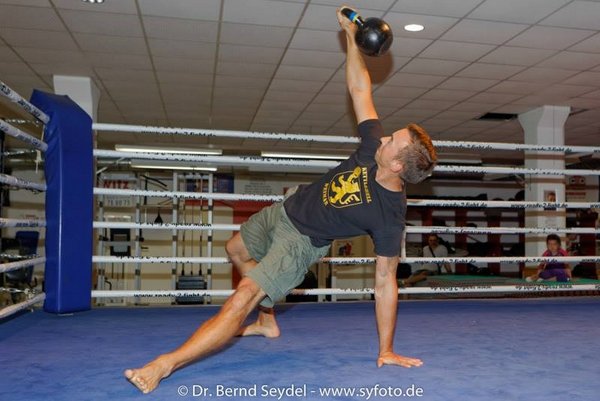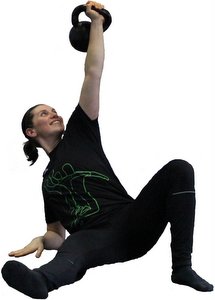
The Turkish get-up… beginners hate it and experienced kettlebellers praise it. The TGU is one of the most fundamental movements because it progresses from lying to standing with a kettlebell. Along with the Hardstyle kettlebell swing, the TGU is one of the basic exercises which will prepare you well for all of the other exercises of the RKC training system.
My earlier post about the get-up was more philosophical and discussed the five things the get-up teaches you about life. Today’s post focuses more on the practical aspects of this movement pattern and how you can implement it in your training to get the most out of it.
 Your body learns to work as a whole unit when performing a Turkish get-up.
Your body learns to work as a whole unit when performing a Turkish get-up.
This exercise integrates every muscle in your body. If there’s a weak spot somewhere, you will find it very quickly—this is also one of the reasons why beginners especially have a hard time with the TGU. The same goes for athletes who are used to training isolated muscles. I have seen many trained 100 kg guys struggling to do their get-ups with a 12 kg kettlebell.
But, this is also what experienced kettlebellers love about the TGU: when you take the time to learn this movement pattern and can flawlessly perform get-ups with a 24 kg kettlebell, many good changes have already happened within your body. The TGU creates flexibility and mobility in the joints along with the basic strength you need to playfully get up from the ground with weight.
Over 200 years ago, Turkish wrestlers already knew that the TGU could prepare them for many things in life. Back then, wrestlers were required to get up while holding half of their body weight in one hand before they could even consider participating in training specific to wrestling. This is also why the get-up is often called the Turkish get-up.
The TGU Consists of 9 Positions, Making It a Complex Exercise.
Take a look at this video of Gini, one of our coaches, doing a 32kg (50% of her body weight) TGU:
What will you gain from frequently practicing and performing Turkish get-ups?
- Improved shoulder stability and flexibility
- The ability to train the whole body as one unit
- A strengthened mid-section improving the reflexive stability of the core, and providing improved injury prevention
- Improved interaction of the muscular chains, intramuscular coordination, and improved interaction between the brain and muscles
- Improved fat burning capacity as large muscle groups are activated causing high calorie demands
Gray Cook, physical therapist and co-founder of Functional Movement Systems refers to the Turkish get-up as “Loaded Yoga”.
There are Tons of Possibilities for Using Turkish Get-Ups in Your Training.
Performing the TGU without weight or with a light weight is a perfect warm-up exercise, or as a component of active recovery/regeneration days. Performed under heavy load, the TGU is one of the best full body strengthening exercises on the planet. For men, a goal of 50% body weight and for women 33% of body weight are absolutely realistic. But as you saw in the video above, these guidelines are relative and can be exceeded!
Another thing that I really like about the get up is how it allows you to lift a weight overhead that you might not be able to press yet. Here is a get-up variation that can help you prepare for heavy presses: choose a weight you can’t (yet) press and bring it over your head by performing a Turkish get-up. Now go take a walk with the weight overhead. By doing this, your body gets used to the weight being in lock-out position overhead and will automatically learn how to stabilize it.
There are tons of get-up variations which provide different focuses on many training aspects. Another variation is performing a bottom-up Turkish get-up to challenge and improve your grip. Hold the kettlebell in a pistol grip (the bottom of the kettlebell will be pointing at the ceiling) and get up from the ground. This is also a great variation for using kettlebells which would ordinarily be too light for your training.
Finally, I have a variation perfect for everyone who has just learned the TGU. This variation will help to “grind” the single positions—it is called the Pyramid. You’ll only need a light kettlebell for it, because you will perform each position repeatedly. Also, be sure to always move into each single position perfectly, and always work in a very controlled manner.
Generally, the Turkish get-up is About Working Slowly and Controlled, Eventually Under a Great Load.
Maybe the get-up is simultaneously so loved and hated is because it can help you get a great deal better, stronger and healthier while rigorously pointing out issues that still need work. Together with the Hardstyle kettlebell swing, it can help you to constantly get constantly stronger, more flexible and even improve your overall endurance.
Hopefully my examples have shown you what an incredibly versatile exercise the TGU is, and that it’s always a good thing to continue improving your get-up.
***
Sebastian Müller, RKC Team Leader, PCC Instructor, FMS, and Primal Move Instructor, trains and instructs at the KRABA location in Wiemar, Germany. He can be contacted by email at: info@kraba-erfurt.de and his website: http://www.kraba-erfurt.de. His Blog is Vereinfachedeintraining.com